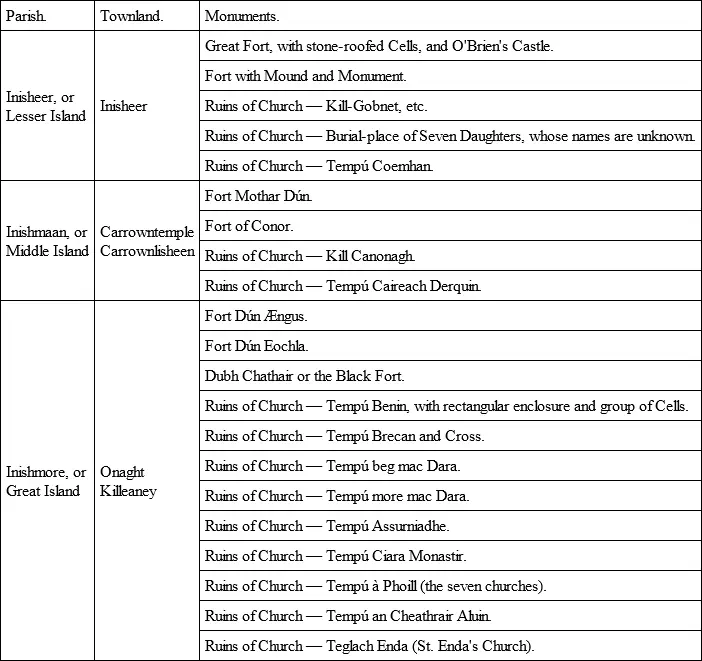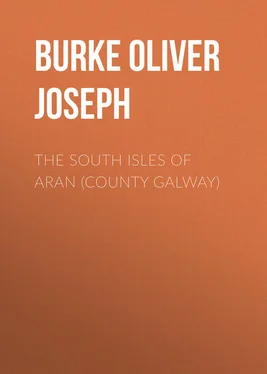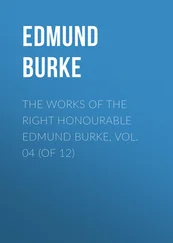Oliver Burke - The South Isles of Aran (County Galway)
Здесь есть возможность читать онлайн «Oliver Burke - The South Isles of Aran (County Galway)» — ознакомительный отрывок электронной книги совершенно бесплатно, а после прочтения отрывка купить полную версию. В некоторых случаях можно слушать аудио, скачать через торрент в формате fb2 и присутствует краткое содержание. ISBN: , Жанр: foreign_antique, foreign_prose, на английском языке. Описание произведения, (предисловие) а так же отзывы посетителей доступны на портале библиотеки ЛибКат.
- Название:The South Isles of Aran (County Galway)
- Автор:
- Жанр:
- Год:неизвестен
- ISBN:http://www.gutenberg.org/ebooks/37840
- Рейтинг книги:4 / 5. Голосов: 1
-
Избранное:Добавить в избранное
- Отзывы:
-
Ваша оценка:
- 80
- 1
- 2
- 3
- 4
- 5
The South Isles of Aran (County Galway): краткое содержание, описание и аннотация
Предлагаем к чтению аннотацию, описание, краткое содержание или предисловие (зависит от того, что написал сам автор книги «The South Isles of Aran (County Galway)»). Если вы не нашли необходимую информацию о книге — напишите в комментариях, мы постараемся отыскать её.
The South Isles of Aran (County Galway) — читать онлайн ознакомительный отрывок
Ниже представлен текст книги, разбитый по страницам. Система сохранения места последней прочитанной страницы, позволяет с удобством читать онлайн бесплатно книгу «The South Isles of Aran (County Galway)», без необходимости каждый раз заново искать на чём Вы остановились. Поставьте закладку, и сможете в любой момент перейти на страницу, на которой закончили чтение.
Интервал:
Закладка:
ST. BRENDAN.
Amongst the remarkable men that there clustered, were St. Kieran, founder of Clonmacnoise, who died in 549, and St. Brendan. The history of the latter abounds with fable, but it is admitted that a thousand years before Christopher Columbus, he crossed the Atlantic and landed on the coast of Florida, where there is a strip of country which, according to Humboldt, in his Cosmos, bore the name of Irland it Milka , "Ireland of the white man." The visit of St. Brendan to Aran, previous to his departure to the great western continent, has been described by one of the most musical of our poets – Denis Florence MacCarthy – as follows: —
"Hearing how blessed Enda lived apart,
Amid the sacred caves of Aran-mör,
And how beneath his eye, spread like a chart,
Lay all the isles of that remotest shore;
And how he had collected in his mind
All that was known to the man of the "old sea," 3 3 The "Old Sea," the ancient name of the Atlantic in Irish.
I left the hill of miracles behind,
And sailed from out the shallow sandy Leigh.
"Again I sailed and crossed the stormy sound,
That lies beneath Binn-Aite's rocky height,
And there upon the shore, the saint I found
Waiting my coming through the tardy night.
He led me to his home beside the wave,
Where with his monks the pious father dwelled,
And to my listening ear he freely gave
The sacred knowledge that his bosom held.
"When I proclaimed the project that I nursed,
How it was for this that I his blessing sought,
An irrepressible cry of joy outburst
From his pure lips, that blessed me for the thought.
He said that he, too, had in visions strayed,
O'er the untrack'd ocean's billowing foam;
Bid me have hope, that God would give me aid,
And bring me safe back to my native home.
"Thus having sought for knowledge and for strength,
For the unheard-of voyage that I planned,
I left those myriad isles, and turned at length
Southward my barque, and sought my native land.
There I made all things ready day by day;
The wicker boat with ox-skins covered o'er,
Chose the good monks, companions of my way,
And waited for the wind to leave the shore."
ST. FINNIAN.
Another of St. Enda's disciples was St. Finnian of Moville – and it was from Aran he set out on his pilgrimage to Rome. Soon after he returned to Ireland, bringing with him a copy of the Gospels, the Papal benediction, and the Canons of St. Finnian. Again departing for Italy, he was made Bishop of Lucca, in Italy, where he died in 588.
ST. COLUMBA.
St. Columba spent years in Aran, and deeply was he grieved at leaving it for Iona. His bitter lament in Irish verse has been translated into English metre by the late Sir Aubrey De Vere, Bart., in part as follows: —
"Farewell to Aran isle, farewell!
I steer for Hy; my heart is sore,
The breakers burst, the billows swell,
'Twixt Aran's isle and Alba's shore.
"Thus spake the son of God, 'Depart!'
Oh Aran isle, God's will be done!
By angels thronged this hour thou art:
I sit within my barque alone.
"Oh Modan, well for thee the while!
Fair falls thy lot and well art thou,
Thy seat is set in Aran isle,
Eastward to Alba turns my prow.
"Oh Aran, sun of all the west!
My heart is thine! as sweet to close
Our dying eyes in thee as rest
Where Peter and where Paul repose.
"Oh Aran, sun of all the west,
My heart its grave hath found;
He walks in regions of the blest,
The man that hears thy church bells sound.
"Oh Aran blest – oh Aran blest!
Accursed the man that loves not thee;
The dead man cradled in thy breast
No demon scares him – well is he." 4 4 Sir Aubrey De Vere, "Irish Odes," p. 274.
ST. FURSA.
Amongst the other ecclesiastical notabilities that frequented Aran in the sixth century was St. Fursa, whose life has been written by scores of writers, as well by the Venerable Bede as by Archbishop Usher, the greatest ornament of the Protestant Church in Ireland. The visions of Fursa were, we are informed by the Rev. J. Carey, in his admirable translation of Dante, the groundwork of the Inferno . The beautiful imagery of Fursa's fancy, which threw a charm over every subject that he handled, may be well illustrated by his rhapsodies on seeing for the first time the city of Rome, as staff in hand he wended his way to the Eternal City. Falling on his knees, with outstretched arms, he exclaimed, "Rome! oh, Rome! I hail thee, admirable by apostolic triumphs. Rome, decorated by the roses of the martyrs, whitened by the lilies of the confessors, crowned by the palms of the virgins, thou that containest the bones and relics of the saints, may thy authority never fade!" 5 5 Colgani, Acta SS. Hiberniæ.
Strange, is it not, that the first sight of the city of Rome should produce in the minds of men feelings which words almost fail to convey!
GIBBON.
It was eleven hundred years after Fursa's first salutation to the city of Rome that Edward Gibbon, when musing amid the ruins of the Capitol whilst the barefooted friars were singing vespers in the temple of Jupiter, formed the idea of writing "The Decline and Fall of the Roman Empire," and what his feelings were on seeing for the first time the holy city he thus in that immortal work informs us: "My temper is not very susceptible of enthusiasm, and the enthusiasm which I do not feel I have ever scorned to affect, but at the distance of twenty-five years, I can neither forget nor express the strong emotions which agitated my mind as I first approached and entered the Eternal City. After a sleepless night I trod with a lofty step the ruins of the Forum." St. Fursa, returning on foot through France, died at Peronne, and his body was conveyed to the island of Aran, where amongst his quondam brethren he now, awaiting the resurrection of the just, reposes.
Of the monuments, as well pre-Christian as Christian, in these islands, there are twenty-one, vested in the secretary of the Commissioners of Public Works in Ireland, to be preserved as national monuments. (See next page.)
RUINS.
Ruins everywhere meet the eye of the tourist in Aran – ruined abbeys, ruined monasteries, ruined nunneries, ruined cells, ruined churches, ruined schools, ruined forts, ruined forests, and ruined towers. With one exception the churches of Aran face the east. I heard somewhere, when on the islands, that that is not exactly true, but that they faced the point of the compass at which the sun rose on the day that the foundation stone was laid. Be that as it may, there is the Oratory of St. Banon, which directly faces the north. It is fifteen feet long, by seventeen feet high to the summit of the gables, by eleven feet in breadth.
COUNTY OF GALWAY.
BARONY OF ARAN.

CLOGHAUNS.
Close by are the remains of the hermitage, partly sunk in the rock, and of some cloghauns, or stone-roofed dwellings. How those solitaries, who for centuries held up the lamp of learning which shone across Europe during the long night which followed the breaking up of the Roman empire, could live in such comfortless cells, it is impossible to apprehend: circular chambers about twenty feet in exterior diameter, with a hole in the stone beehive roof for a chimney, and with an Egyptian-like doorway that a tall man could with difficulty enter. Teampul-Chiarain has a beautiful eastern window, with some crosses. Four miles from Kilronan are Kilmurvey and Teampul McDuach , a sixth-century church, consisting of nave and choir in beautiful preservation. There are windows there of remote antiquity, with lintels formed of two leaning stones; and there is a semicircular window of great beauty of a more recent date. There is a stone leaning against the eastern gable with a rudely cut opening which seems to have been the head of the more ancient window. The narrow doorway is like the entrance to an Egyptian tomb. Another small church, Teampul-beg , together with a holy well and monastic enclosure, is worthy of inspection. At the north-western side of the Inishmore island, and six miles from Kilronan, are the remains of the seven churches, one of which is called Teampul Brecain – the church of St. Braccan, who was the founder of the monastery of Ardbraccan, now the cathedral church of the diocese of Meath. The ruined church of Teampul-saght-Machree is an object of interest on the middle island. The eastern island in ancient times was called Aran-Coemhan in honour of St. Coemhan (St. Kevin), brother of St. Kevin of Glendalough. He was one of the most renowned of the saints of Aran, and is believed to have not unfrequently abated storms after being piously invoked.
Читать дальшеИнтервал:
Закладка:
Похожие книги на «The South Isles of Aran (County Galway)»
Представляем Вашему вниманию похожие книги на «The South Isles of Aran (County Galway)» списком для выбора. Мы отобрали схожую по названию и смыслу литературу в надежде предоставить читателям больше вариантов отыскать новые, интересные, ещё непрочитанные произведения.
Обсуждение, отзывы о книге «The South Isles of Aran (County Galway)» и просто собственные мнения читателей. Оставьте ваши комментарии, напишите, что Вы думаете о произведении, его смысле или главных героях. Укажите что конкретно понравилось, а что нет, и почему Вы так считаете.












